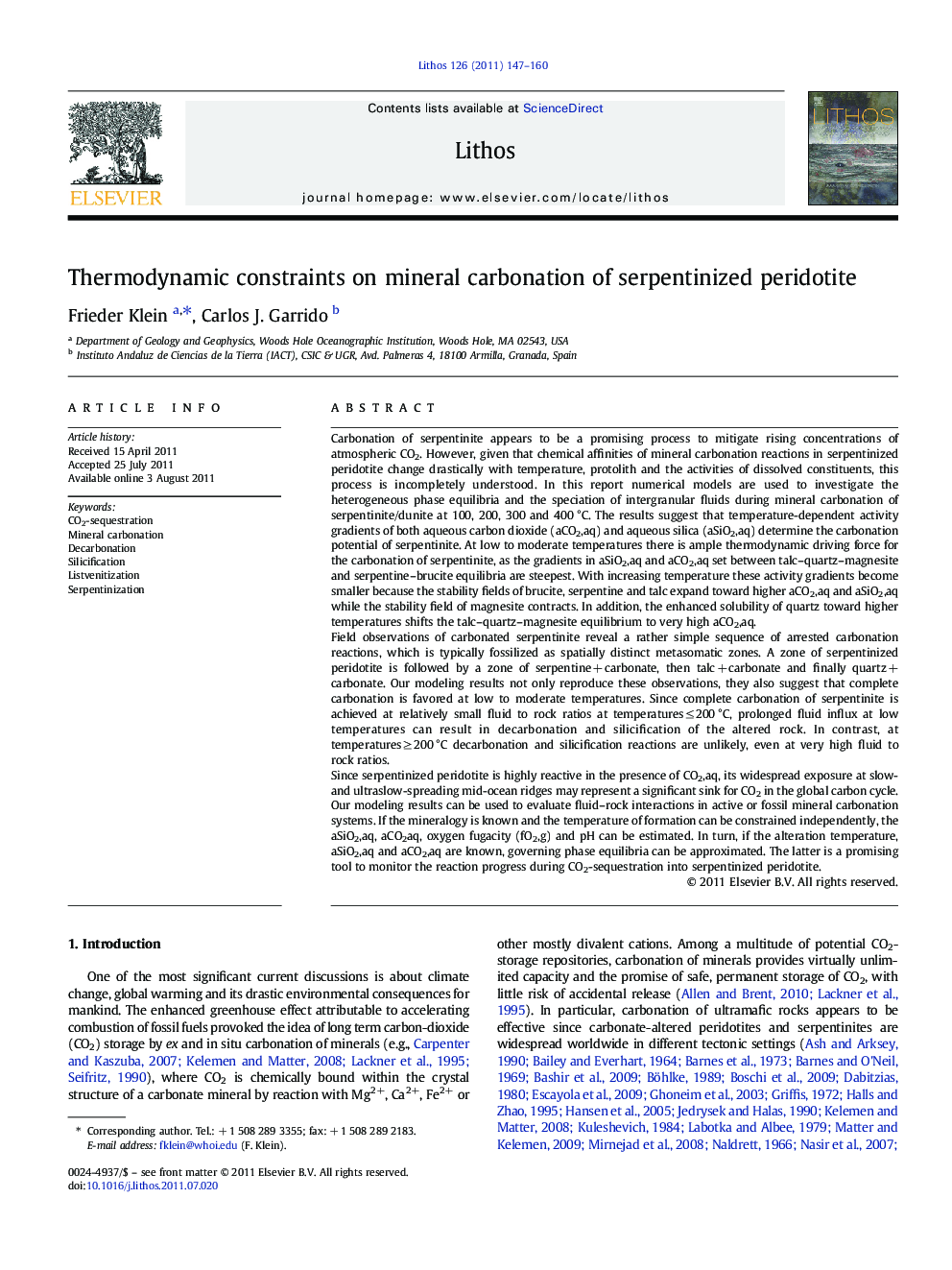| کد مقاله | کد نشریه | سال انتشار | مقاله انگلیسی | نسخه تمام متن |
|---|---|---|---|---|
| 4716707 | 1638716 | 2011 | 14 صفحه PDF | دانلود رایگان |

Carbonation of serpentinite appears to be a promising process to mitigate rising concentrations of atmospheric CO2. However, given that chemical affinities of mineral carbonation reactions in serpentinized peridotite change drastically with temperature, protolith and the activities of dissolved constituents, this process is incompletely understood. In this report numerical models are used to investigate the heterogeneous phase equilibria and the speciation of intergranular fluids during mineral carbonation of serpentinite/dunite at 100, 200, 300 and 400 °C. The results suggest that temperature-dependent activity gradients of both aqueous carbon dioxide (aCO2,aq) and aqueous silica (aSiO2,aq) determine the carbonation potential of serpentinite. At low to moderate temperatures there is ample thermodynamic driving force for the carbonation of serpentinite, as the gradients in aSiO2,aq and aCO2,aq set between talc–quartz–magnesite and serpentine–brucite equilibria are steepest. With increasing temperature these activity gradients become smaller because the stability fields of brucite, serpentine and talc expand toward higher aCO2,aq and aSiO2,aq while the stability field of magnesite contracts. In addition, the enhanced solubility of quartz toward higher temperatures shifts the talc–quartz–magnesite equilibrium to very high aCO2,aq.Field observations of carbonated serpentinite reveal a rather simple sequence of arrested carbonation reactions, which is typically fossilized as spatially distinct metasomatic zones. A zone of serpentinized peridotite is followed by a zone of serpentine + carbonate, then talc + carbonate and finally quartz + carbonate. Our modeling results not only reproduce these observations, they also suggest that complete carbonation is favored at low to moderate temperatures. Since complete carbonation of serpentinite is achieved at relatively small fluid to rock ratios at temperatures ≤ 200 °C, prolonged fluid influx at low temperatures can result in decarbonation and silicification of the altered rock. In contrast, at temperatures ≥ 200 °C decarbonation and silicification reactions are unlikely, even at very high fluid to rock ratios.Since serpentinized peridotite is highly reactive in the presence of CO2,aq, its widespread exposure at slow- and ultraslow-spreading mid-ocean ridges may represent a significant sink for CO2 in the global carbon cycle.Our modeling results can be used to evaluate fluid–rock interactions in active or fossil mineral carbonation systems. If the mineralogy is known and the temperature of formation can be constrained independently, the aSiO2,aq, aCO2aq, oxygen fugacity (fO2,g) and pH can be estimated. In turn, if the alteration temperature, aSiO2,aq and aCO2,aq are known, governing phase equilibria can be approximated. The latter is a promising tool to monitor the reaction progress during CO2-sequestration into serpentinized peridotite.
► We present numerical models for low and high temperature carbonation of serpentinite.
► Temperature-dependent activity gradients in SiO2,aq and CO2,aq control the carbonation potential of serpentinite.
► Our models are a promising tool in assessing fluid-rock equilibria in active and fossil carbonation systems.
► Abyssal serpentinite may act as a significant sink for CO2 in the global carbon cycle.
Journal: Lithos - Volume 126, Issues 3–4, October 2011, Pages 147–160